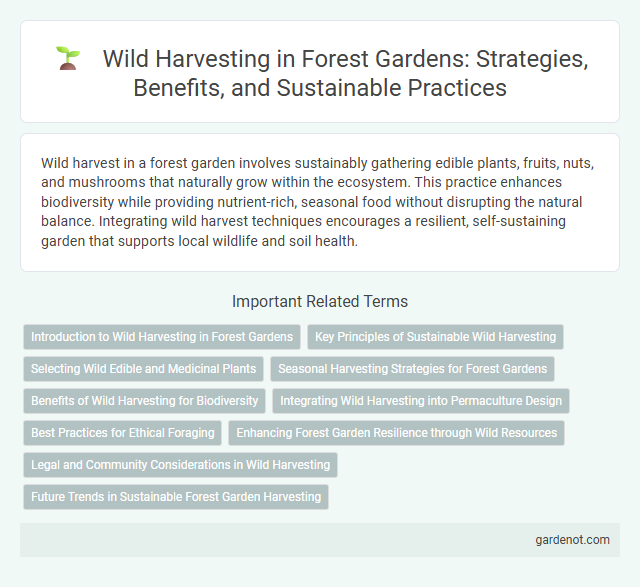Wild harvest in a forest garden involves sustainably gathering edible plants, fruits, nuts, and mushrooms that naturally grow within the ecosystem. This practice enhances biodiversity while providing nutrient-rich, seasonal food without disrupting the natural balance. Integrating wild harvest techniques encourages a resilient, self-sustaining garden that supports local wildlife and soil health.
Introduction to Wild Harvesting in Forest Gardens
Wild harvesting in forest gardens involves sustainably collecting native plants, fruits, nuts, and medicinal herbs that naturally thrive in multi-layered ecosystems designed to mimic natural forests. This practice supports biodiversity by encouraging the growth of diverse species while providing nutrient-rich, seasonal food and resources without the need for intensive cultivation. Emphasizing ethical foraging ensures the regeneration of wild populations, contributing to ecological balance and enriching the forest garden's productivity.
Key Principles of Sustainable Wild Harvesting
Sustainable wild harvesting in forest gardens emphasizes minimal environmental impact, ensuring long-term availability of native plant species by adhering to selective gathering techniques that prevent overharvesting. Key principles include respecting local ecosystems, harvesting only mature or abundant specimens, and maintaining biodiversity to support ecological balance. These practices foster regeneration and protect wildlife habitats, aligning with conservation goals and ethical foraging standards.
Selecting Wild Edible and Medicinal Plants
Selecting wild edible and medicinal plants for a forest garden requires thorough knowledge of local flora and seasonal growth patterns. Prioritize species that thrive in native ecosystems, such as wild garlic, dandelion, and elderberry, which offer both nutritional and therapeutic benefits. Proper identification, sustainable harvesting techniques, and awareness of plant toxicity are essential to maintain ecosystem balance and ensure safety.
Seasonal Harvesting Strategies for Forest Gardens
Seasonal harvesting strategies in forest gardens involve timing wild harvests to maximize yield and sustainability, focusing on the natural growth cycles of native plants and trees. Early spring yields include young shoots and wild greens, while summer offers fruits, berries, and medicinal herbs, with late autumn suitable for nuts, seeds, and roots. Integrating knowledge of phenology and local climate patterns ensures continuous forage availability, promotes biodiversity, and supports ecosystem health in forest garden management.
Benefits of Wild Harvesting for Biodiversity
Wild harvesting in forest gardens supports biodiversity by preserving native plant species and providing habitats for various wildlife. This practice encourages natural regeneration and maintains ecological balance by minimizing disturbance to the soil and surrounding vegetation. Sustainable wild harvesting enhances ecosystem resilience and promotes genetic diversity critical for long-term forest health.
Integrating Wild Harvesting into Permaculture Design
Integrating wild harvesting into permaculture design enhances biodiversity and promotes sustainable food systems by utilizing native plants and natural ecosystems. Wild harvesting supports soil health and ecosystem resilience through minimal disturbance and natural regeneration. Incorporating native edible species in forest gardens provides a continuous, low-maintenance yield while preserving local flora and fauna.
Best Practices for Ethical Foraging
Harvesting wild plants from forest gardens requires careful identification to avoid endangered species and ensure sustainable populations. Foragers should collect only what is needed, leaving ample resources for wildlife and future growth. Practicing seasonal awareness and minimal disturbance techniques protects ecosystem balance and promotes long-term biodiversity.
Enhancing Forest Garden Resilience through Wild Resources
Incorporating wild harvest strategies enhances forest garden resilience by diversifying species and improving ecosystem stability. Utilizing native wild plants supports soil health, promotes natural pest control, and adapts to climatic variations. Harnessing wild resources creates a sustainable, self-regenerating forest garden system resistant to environmental stressors.
Legal and Community Considerations in Wild Harvesting
Wild harvesting in forest gardens requires adherence to local, state, and federal laws regulating collection permits and protected species to ensure sustainable practices and forest conservation. Engaging with community groups and indigenous peoples promotes ethical harvesting, respecting traditional knowledge and shared resources. Clear understanding of legal frameworks and cooperative stewardship fosters responsible wild harvesting, safeguarding biodiversity and community rights.
Future Trends in Sustainable Forest Garden Harvesting
Future trends in sustainable forest garden harvesting emphasize integrating advanced agroforestry techniques with digital monitoring systems to optimize yield and biodiversity. Embracing regenerative practices, such as selective wild harvest and polyculture layering, improves soil health and promotes ecosystem resilience. Innovations in eco-friendly harvesting tools and community-led management models are set to enhance productivity while preserving forest garden ecosystems for generations.
Wild harvest Infographic

 gardenot.com
gardenot.com